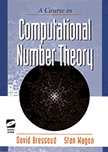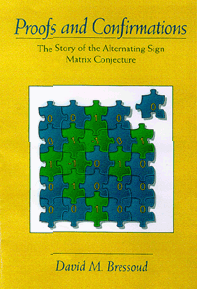BOOKS and VIDEOS

Calculus Reordered: A History of the Big Ideas. 2019
Calculus Reordered takes readers on a remarkable journey through hundreds of years to tell the story of how calculus evolved into the subject we know today. I explain why calculus is credited to seventeenth-century figures Isaac Newton and Gottfried Leibniz, and how its current structure is based on developments that arose in the nineteenth century. Bressoud argues that a pedagogy informed by the historical development of calculus represents a sounder way for students to learn this fascinating area of mathematics.Click HERE to see Table of Contents and Preface. Here are the corrections. Available from Princeton University Press.
Video introduction (in English) to the Chinese Edition of Calculus Reordered.

Calculus: Graphical, Numerical, Algebraic (6th edition). 2019. Jointly authored with Demana, Waits, Kennedy, and Boardman.
A high school calculus text aligned with the AP Calculus courses. One of the most innovative aspects is that the definite integral is defined in terms of Darboux sums, pointing out that they bound the possible values of Riemann sums.
I have drafted a resource for students and teachers, Context for Calculus, available at https://tinyurl.com/context4calc, explaining the background behind most of the concepts of AP Calculus. It was written with the idea of using it as a supplement for the 6th edition of Calculus: Graphical, Numerical, Algebraic , but aside from some references to specific pages, there is no reason it could not be used with any other textbook.
This is a draft. I would greatly appreciate feedback including corrections, notes on what is helpful, and notes on what is unclear or confusing. My email is bressoud@macalester.edu.

A Radical Approach to Lebesgue's Theory of Integration. 2008.
This is a sequel to A Radical Approach to Real Analysis. That book ended with Riemann's definition of the integral. That is where this text begins. All of the topics that one might expect to find in an undergraduate analysis book that were not in ARATRA are contained here, including the topology of the real number line, fundamentals of set theory, transfinite cardinals, the Bolzano–Weierstrass theorem, and the Heine–Borel theorem. I did not include them in the first volume because I felt I could not do them justice there and because, historically, they are quite sophisticated insights that did not arise until the second half of the 19th century.
This book owes a tremendous debt to Thomas Hawkins' Lebesgue's Theory of Integration: Its Origins and Development. Like ARATRA, my book is not intended to be read as a history of the development of analysis. Rather, it is a textbook informed by history, attempting to communicate the motivations, uncertainties, and difficulties surrounding the key concepts. Click here for a list of corrections.

Queen of the Sciences: A History of Mathematics. 2008.
The Queen of the Sciences takes you from ancient Mesopotamia—where the Pythagorean theorem was already in use more than 1,000 years before the Greek thinker Pythagoras traditionally proved it—to the Human Genome Project, which uses sophisticated mathematical techniques to decipher the 3 billion letters of the human genetic code.
Along the way, you meet a remarkable range of individuals whose love of numbers, patterns, and shapes created the grand edifice that is mathematics. These include astrologers, lawyers, a poet, a cult leader, a tax assessor, the author of the most popular textbook ever written, a high school teacher, a blind grandfather, an artist, and several prodigies who died too young.

A Radical Approach to Real Analysis 2nd edition, 2006.
This is an introduction to real analysis that begins with the problems the led to the development of this subject. It starts with Fourier series and the difficulties it presented for mathematicians of the early 1800s. It presents both successes and failures and explains how and why the fundamental definitions and theorems of real analysis came to be.
Click here to access the Web Resources for the second edition of A Radical Approach to Real Analysis. Click here for the Errata to the second edition.

A Course in Computational Number Theory, 2000. Co-authored with Stan Wagon
We have a Mathematica file of the strong pseudoprimes: StrongPseudoprimeData.m and a list of corrections. The file CNT.m is consistent with Mathematica versions 6.0and 7.0.
This is an introduction to number theory couched in an exploratory, computation rich setting that makes extensive use of Mathematica. Topics include the Euclidean Algorithm, modular arithmetic, linear congruences, Chinese Remainder Theorem, Fermat's Little Theorem and pseudoprimes, Euler's phi, perfect numbers, primitive roots and orders, distribution of primes, prime testing and certification, RSA, check digits, factoring algorithms, quadratic residues and reciprocity, Pepin's test, continued fractions, Pell's equation, CFRAC, Lucas sequences for prime certification and factorization and the Lucas-Lehmer algorithm, representations as sums of squares, Gaussian primes.

Proofs and Confirmations: the Story of the Alternating Sign Matrix Conjecture. 1999.
This is the story of the proof of the alternating sign matrix conjecture written at a level accessible to anyone who has had a course in linear algebra. It describes recent research in algebraic combinatorics, using this example to illustrate the surprising twists and turns of actual mathematical research. It is also an opportunity to explore some of the related fields that fed into the ultimate solution. These include partition theory, plane partitions, symmetric functions, hypergeometric and basic hypergeometric series, lattice path counting problems, and the Yang-Baxter equations of statistical mechanics. A notebook of the Mathematica commands is available as well as corrections. Solutions and hints for selected exercises in chapters 1-4 are available as a PDF file. Kim-Ee Yeoh at Wisconsin has posted JAVA programs for finding and counting alternating sign matrices.

Second Year Calculus: from Celestial Mechanics to Special Relativity. 1991.
This is a vector calculus textbook that empahsizes the language of differential forms and the physical motivation for the topics encountered. The first and third chapters describe celestial mechanics and the latter chapters deal with electricity and magnetism and show how the symmetries of Maxwell's equations lead to special relativity. The book concludes with a proof that E=mc^2. There are two pdf files of corrections to the 4th printing: calc_corrections-1.pdf and calc_corrections-2.pdf.

Factorization and Primality Testing. 1989.
This is really an introduction to Number Theory that is built around around the twin problems of how to determine whether a large integer is prime and, if it is not, how to factor it into its prime factors. It includes descriptions of the RSA public-key cryptosystem, the Multiple Polynomial Quadratic Sieve, and the Elliptic Curve methods for factorization and primality testing. A pdf file of the corrections is available.
Analytic and Combinatorial Generalizations of the Rogers-Ramanujan Identities. 1980. Memoirs of the American Mathematical Society.

